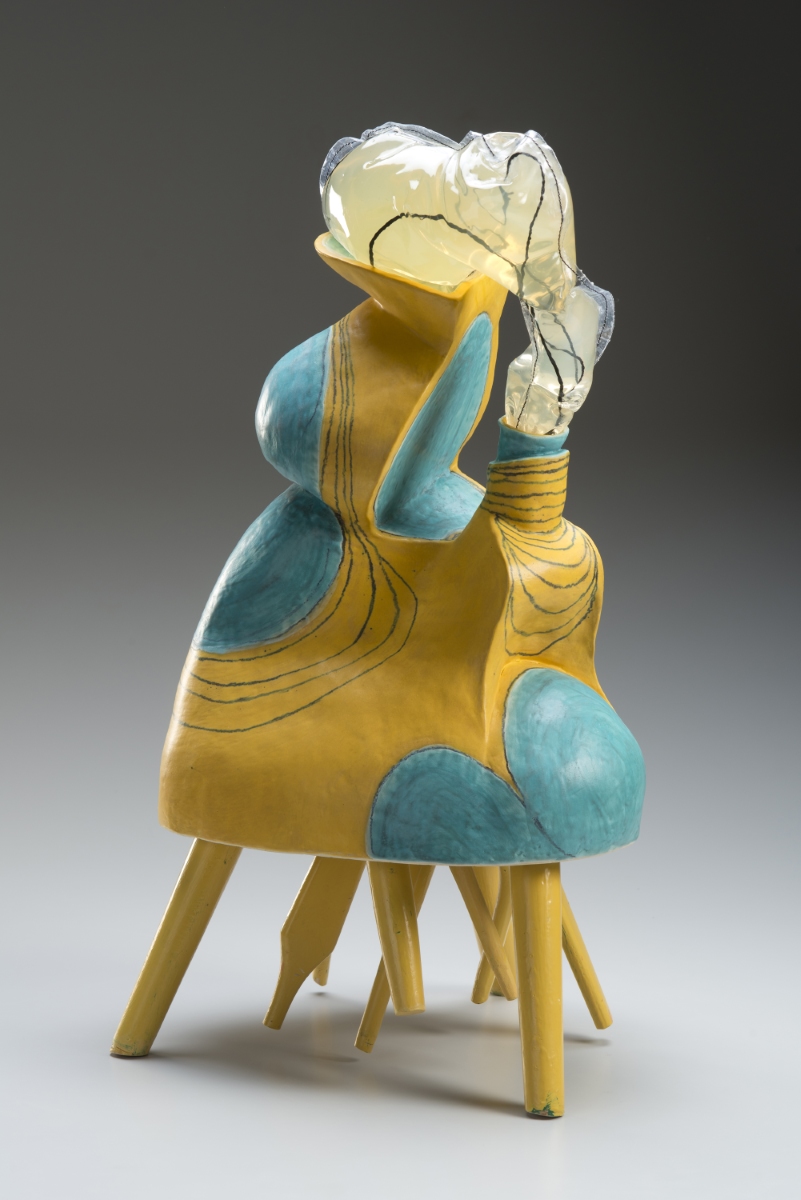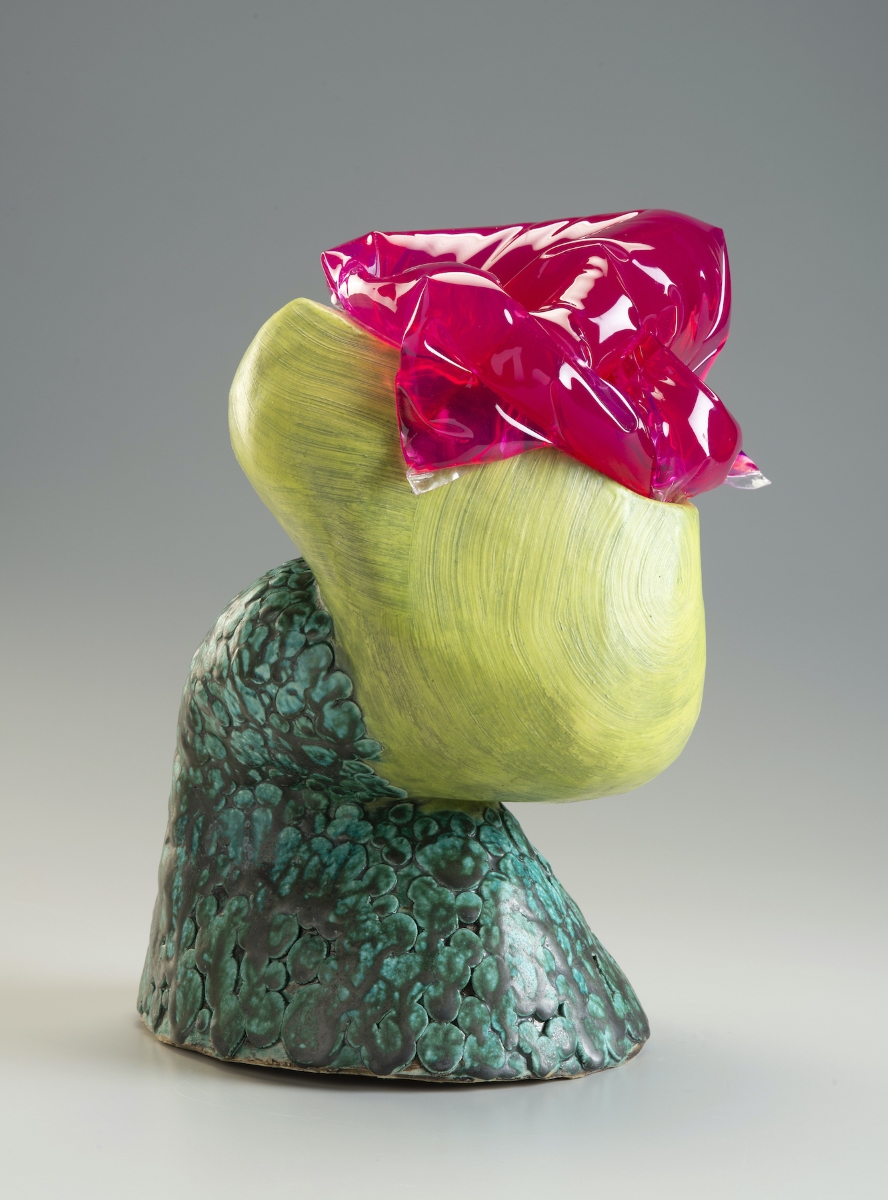Laura Van Duren is an abstract sculptor born in Pittsburgh, Pennsylvania, now based in Oakland, California. Her work has been shown throughout California and the United States. She is one of the founding members of Mercury 20 Gallery, situated in the heart of Oakland California’s art scene. She received her BFA in drawing from Carnegie Mellon University and completed her MFA in sculpture at San Francisco State University in 2017. She works with the Peter Voulkos family helping to manage the archival aspect of his collection which has had a profound influence on her practice. She is an adjunct professor teaching ceramics and sculpture at multiple community colleges in the San Francisco Bay Area.
“Conceptually, I am interested in reflecting the unconscious dialogue between the brain and the body, drawing upon the theory of embodied cognition. I am curious about the role the body plays in our emotional perception of the world. How do our bodies influence our minds? How does our corporeal wisdom influence our perception of the world? Investigating these questions through the process of casting, cutting, and reassembling, I mirror the act of adaption, letting my intuition shape the work. I tap into the unconscious guidance of my own body, creating abstract sculptures that reach beyond the rational mind. My materials are a combination of clay, glycerin, found furniture and thread. The forms I create have a unique interdependence with each other, weaving a seductive language of unpredictability and playfulness.”
Visit Laura Van Duren’s website and Instagram page.
Featured work
Selected works, 2020-2023


Laura Van Duren: Drawing the line
Article by Maria Porges
1.
The hand is the tool of tools.
Aristotle
Cast, shaped by hand or tool; sewed or scavenged, muted in tone or vividly-colorful, the parts of Laura van Duren’s sculptures are drawn together into animated wholes, vibrating with an energy that is as startling as it is sometimes hilarious. Some pieces seem as if they could walk or roll away on the adapted fragments of found furniture that support them—bits of chairs or tables that sometimes end in casters, strapped onto odd bodies like prosthetic limbs. At times, Van Duren’s inventions suggest the cyborg denizens of a dystopic future in which such creatures might stand in for various organs, taking over aspects of our bodily functions. In other works, wooden elements seem to frame or contain the shapelessness of softer parts, much in the way that our skeletons provide shelter. And some push towards pure abstraction, in complementary combinations of color and dynamic form.
Over the past five years, Van Duren’s novel and sometimes startling deployment of an extensive range of materials and methods has resulted in a body of wholly original work. In pieces like Looping or The Extrovert, translucent shapes of cast glycerin sewn into shiny pockets of vinyl offer a mesmerizing contrast to the obdurate opacity and weight of clay. Van Duren often creates a connection between the parts of such works with color; the orange stitching in Looping, for example, echoes the glaze on the ceramic form through which the intestine-like sewn vinyl seems to form a continuous conduit.
In The Extrovert, blue and orange appear throughout the piece. Our eyes travel from the glaze on the ceramic form to the stitching on the vinyl, both orange, or from the bluish tint of the glycerin back to the brushed translucent turquoise band that bifurcates the acrobatic-looking clay part of the sculpture. Still, the connection that is most striking in this piece is the way sketched lines on the ceramic surface—sometimes echoing its forms, sometimes dividing them– seem to continue, crossing from one medium to the other, entering the vinyl– where a long piece of dark twisted wire undulates through its curving form. The more you look at it, the more the wire becomes a kind of mark as much as it is a physical thing.
2.
I believe that if you really want to understand an object you must draw it.
L.V.D.
Despite their assertive, three-dimensional physicality: both in the sense of relating to the body, and in that they have a powerful presence—two dimensional drawing is an essential part of these pieces. For decades, everywhere Van Duren has spent time, she has filled sketchbooks with her observations. From doctor’s office waiting rooms to trains, parks, jazz clubs and even while watching presidential debates, she has created a kind of visual journal of her experiences. Not surprisingly, her undergraduate degree from Carnegie Mellon University was in drawing (she discovered clay soon afterwards).
In addition to recording what she sees, Van Duren sometimes covers pages with abstract biomorphic shapes, some of which are later translated into sculptures. She is fascinated by old medical textbooks, finding that their engraved illustrations of parts of the body offer a seemingly endless vocabulary of unexpected form.
Lines on the surfaces of her newest pieces become yet another kind of drawing. In Rendering, repeated marks circle parts of the central ceramic form, emphasizing each undulation. On Pillar, drawn lines interact dynamically with areas of color that accentuate the work’s knobbly, topiary-like form. The wooden support that completes the piece was inspired by the ‘crutches’ she saw in a park in Venice, holding up trees. Finally, the wire that binds wood to clay becomes a drawing as well.
Sometimes, however, Van Duren just sits down to draw an image that later becomes an object, an experience she describes as a kind of magic.
3.
Every master knows that the material teaches the artist.
Ilya Ehrenberg
After a career in ceramics spanning two decades, Van Duren decided to get an MFA at San Francisco State University, completing the degree in 2017. While in graduate school, she began to use a new material. She had been casting resin, attracted to its translucence and ability to carry color, but wanted to find a less toxic alternative. When she saw a piece of glycerin soap in a friend’s bathroom she realized its potential.
For Van Duren, glycerin’s impermanence is part of its beauty. “It sweats when it rains,” she told me, pointing to the bumps that had formed along the bottom edge of a piece from several years ago, their relief formed by successive exudations. Still, despite the conceptual beauty of such transience, she realized that she needed to find a way to preserve her cast forms. In 2018, she began sewing clear vinyl sleeves for them on an ancient industrial machine once used to make shoes.
As she experimented with integrating this new material, she began to use the machine as a drawing tool. In pieces like Reassurance or Pink Bite, dangling threads become a series of lines, extending her mark-making in yet another way. The stitched outlines of pieces like Embracing Eva or Speaking Inside Out emphasize the almost calligraphic curves created by the glycerin and (again) twisted wire, encased inside the vinyl. The ceramic elements in both works, their shapes quixotic yet confident, demonstrate that Van Duren knows what clay can do. Even if the clay, as she puts it, wants to go one way, she can persuade it to go another.
4.
Van Duren has taught ceramics at a number of Bay Area schools. In 2019, having broken her wrist, she was forced to use her non-dominant hand not only to demonstrate techniques for her classes but to make her own work. The experience made her curious about how the body simultaneously holds the memory of trauma and more positive experience—how it serves as both the messenger and the vessel for injury and recovery.
Her pieces often evoke the support systems that we develop from such accidents– the prosthetics, whether temporary or permanent, seen or invisible, that form a web around us. Her sculpture embodies an extraordinary drive to expand and learn. There is neither time nor material to waste, so she uses it all.
About the author
Since the late ‘80s, Maria Porges has pursued dual practices as both writer and artist, currently teaching in both areas at California College of the Arts. A graduate of Yale University (BA) and the University of Chicago (MFA), her critical writing has been published widely in Artforum, Sculpture, American Ceramics, Hyperallergic, the New York Times Book Review, and a host of now-defunct art and craft magazines. Porges has also authored essays for more than 120 exhibition catalogs and multiple book contributions.














